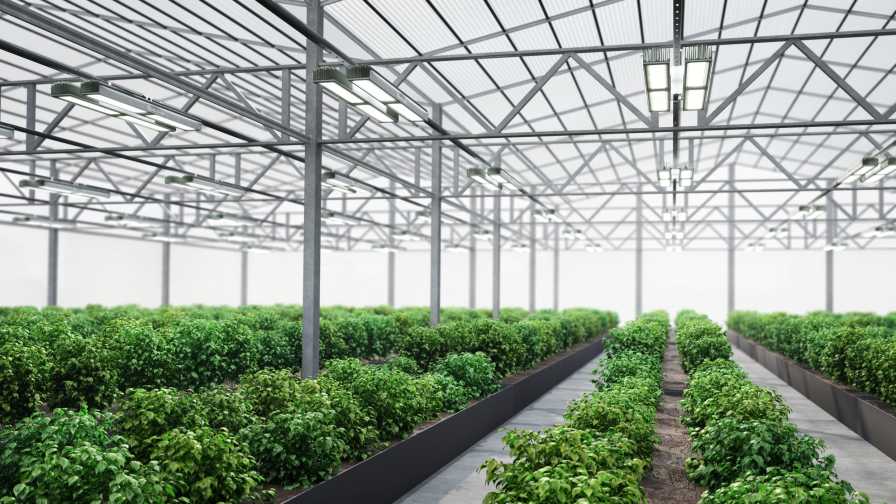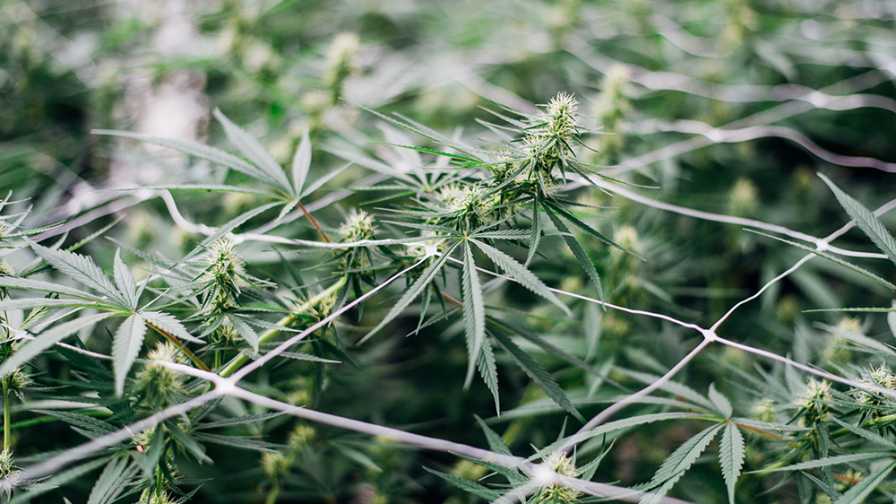Greenhouse Lighting and Beyond: New Tech Helps Growers Make Decisions

Lighting companies are adding ag tech features to fixtures in a quest to help growers manage labor and make better decisions.
Photo courtesy of Heliospectra
When you think about it in terms of data collection, in the greenhouse there’s really no better vessel for deploying sensing technologies over the canopy than the lighting fixture itself.
To the most ubiquitous fixed asset under glass, positioned with the ideal bird’s eye view of crops for imagery and crop change detection, lighting companies are adding sensors and cameras, as well as data collection and edge-processing technologies to the mix in a quest to help growers drive efficient remote management.
Where’s the Interest?
This trend is even more pronounced on the legal cannabis and indoor hemp side of the horticulture coin, as the growers having early success in those crops have a plethora of funds to use on tech adoption.
“I think there’s more excitement in that [part of the] industry right now among the customers, because the narrative is out there that if we can grow a good plant, we’ll make a ton of money,” says Chris Higgins, Founder and Owner at Hort Americas, a horticulture supplies company that also offers consulting services to growers.
“I think when you get to the ornamental and vegetable side, the growers typically are more experienced with their crops, and they’re a little more skeptical of the technology until it proves out,” Higgins says. “Cannabis growers are just willing to take more risks right now. They have more access to capital, and the margins aren’t nearly as small, so the ability to get them a higher return on investment is there.”
When it comes to lighting add-on technologies, Higgins divides the market into two categories: sensors that purely produce output data and those that output data and initiate control of some aspect of the greenhouse structure and the various technologies deployed throughout.
“You can start inexpensively by just using sensors and collecting the data,” Higgins says. “It doesn’t get expensive until you take all the data and those sensors, and then you try to make it control something, like lighting or climate. If it’s just collecting data, use that data to find the gaps that you need to fix, and then figure out how you want to make your first investments.
“And data is only good if you use it,” he adds. “So, assign someone to track the data. Data is knowledge, and if you’re being price pressured, the more data that you have access to, the more that’s going to help your operation become more efficient.”
Manufacturers Weigh In
The lighting technology market in its massive totality is vast and rapidly changing and evolving around the globe, even as we speak, that to survey the entire market would be virtually impossible.
With that in mind, we reached out to a handful of notable commercial providers of lighting and integrated add-on technologies to try to get a sense of what growers are demanding from this segment of the tech world.
Fluence by Osram
Sean Sangster, a Horticulture Specialist with Fluence by Osram, weighed in on what the company is seeing and hearing from growers.
“Most growers are looking to integrate more advanced adaptive lighting solutions into their existing greenhouse environments, to keep daily light integral (DLI) levels constant throughout the entire grow cycle,” Sangster says.
Growing under glass, those DLI levels can be automatically adjusted for outside environmental conditions, like turning up the intensity during a period of grey, rainy days in the growing season.
“Consistent DLI levels are largely dependent on external environmental factors like seasonal changes (summer to fall), rain/overcast weather, and geographic location of the greenhouse,” Sangster says. “Adaptive lighting powered by PAR (Photosynthetic Active Radiation) sensors reduces the effects these external variables have on a crop, creating the ideal conditions for plants.”
Heliospectra
Heliospectra is another company seeing growing interest in its products from the legal cannabis segment. Ryan Wankel, the companies’ Cannabis Grower Liaison, says his current focus is dialing in lighting recipes for cannabis production.
“You can design strategies for specific seeds or strains to truly mimic the sun and natural light quality based on the region or part of the world the strain originated from,” Wankel says. “These strain-specific lighting strategies can be applied at specific points in the plant’s development and with adjustable spectrum LEDs you can enable the grower to influence not only the secondary metabolites (terpenes), but also the flower quality.”

One of the easiest sells for lighting add-on features has been the legal cannabis and hemp segments, where high wholesale prices and grower optimism have enabled growers to invest in tech.
Photo courtesy of Heliospectra
Wankel says his company is also taking a hard look at indoor vertical farming as a growth segment for horticulture going forward, as grower interest in optimizing every inch of floor space in the greenhouse has never been higher.
“Our growers and customers are focused on becoming the most efficient, sustainable, and profitable farms possible,” he says. “Many continue to diversify or rotate a wide variety of crops through their greenhouse facilities to use space year-round and increase revenue.”
LumiGrow
LumiGrow (Emeryville, CA) is yet another entrant into the sensing and data-driven lighting innovator market. Brandon Newkirk, the company’s Marketing Director, says that targeted, adjustable light-spectrum recipes, wireless control of fixtures, as well as a handful of sensor packages, are among the add-ons the group has been focused on delivering to the market.
“As most growers already know, plant life is too variable not to have some of this stuff in the greenhouse, and it’s changing the way you’re looking at lighting,” he says. “It’s become a dynamic tool, not just something you hang and forget about. We believe that all aspects of lighting must be constantly improved upon, so the grower can get the most profit from production.”
As a provider of LED-based solutions, Newkirk and Co. understand firsthand the many challenges that surround that market segment. He harkens back to the age-old adage, Keep It Simple, Stupid (KISS).
“Our goal is to make it as simple for people to understand as possible, and of course to improve yields, and plant quality, all those things our growers are looking for from their lighting,” Newkirk says. “We’re more and more seeing ourselves as a service provider. We ask growers what crop they are looking at, what their goals are, and we get our in-house research team involved to come up with a strategy.”
One of the many interesting new technologies at LumiGrow is its Spore Cam, a disease recognition sensor that integrates with its SmartPAR sensor. How it works is rather intriguing: the sensor pulls in air from the canopy and the air is passed over a piece of film. A camera then takes pictures of those microscopic particles, and the images are sent off to the cloud for processing. When the system detects disease spores or any other pathogen, it recognizes them on the tape and notifies the grower.
“This helps growers understand if they have disease pressure in the room before the plants get sick, then they can get ahead with a pre-treatment,” Newkirk adds.
Illumitex
Illumitex is doing some change detection sensing work in greenhouses via the lighting fixture.
Jeff Bisberg is the company’s CEO and chief evangelist for its integrated FarmVisionAI remote monitoring solution. FarmVisionAI uses an integrated camera that captures imagery around the clock and uses edge computing to run AI algorithms over the captured imagery of the plants to measure and rank the levels of output or production from the plants. It also has a historical database that Bisberg likens to a time-traveling feature to provide a historic context of past production.
“There’s three areas we see this imagery-driven management tool as being beneficial to growers,” Bisberg says. “Number one is alleviating issues with crop scouting, and then it becomes a question of loss prevention. How do we reduce plant losses and create urgency around those farming tasks that need to be prioritized? And then the third area is in helping manage labor.”

Illumitex’s NeoPARXO features the company’s FarmVisionAI integrated into the light fixture. It’s a hi-resolution camera that captures images of the plants every hour. The images are securely pushed to the cloud in a visualization system, sort of like Google Earth inside the farm.
Image courtesy of Illumitex
Bisberg says FarmVisionAI is a visualization tool that is constantly capturing data from above the crop, shifting the way the group markets the innovation from your typical product-based to more of a solutions-based pitch.
“We’d like this to fit into the grower’s workflow and not the other way around,” he says. “Maybe you spend an hour every morning scouting the farm? Some people do it twice a day. Maybe now you sit at the computer and check all your plants to see if anything bad happened over the evening.
“Farming is about the visual. I mean, that really gets to the core of farming,” Bisberg continues. “There are so many sensors out there that just spew out digital data. I’m a numbers guy and even my brain goes numb looking at all that data. Thinking about it through the growers’ eyes, how does a farmer want to look at the crop, and then we overlay that data on top of the farm. In that sense, the visualization overlay, when you start with that perspective, I think it just intuitively fits into their workflows.”
Although referring directly to his product and its approach to the market, Bisberg’s last point pretty much sums up the entirety of lighting tech add-ons and what they are all meant to accomplish.
“The idea is helping the farmer make better decisions faster, and the way we see it is indoor is about square footage, and how do you make more value out of square footage? It’s providing new tools, specifically visualization tools with data overlaid, to help them meaningfully increase that crop production,” Bisberg says.










